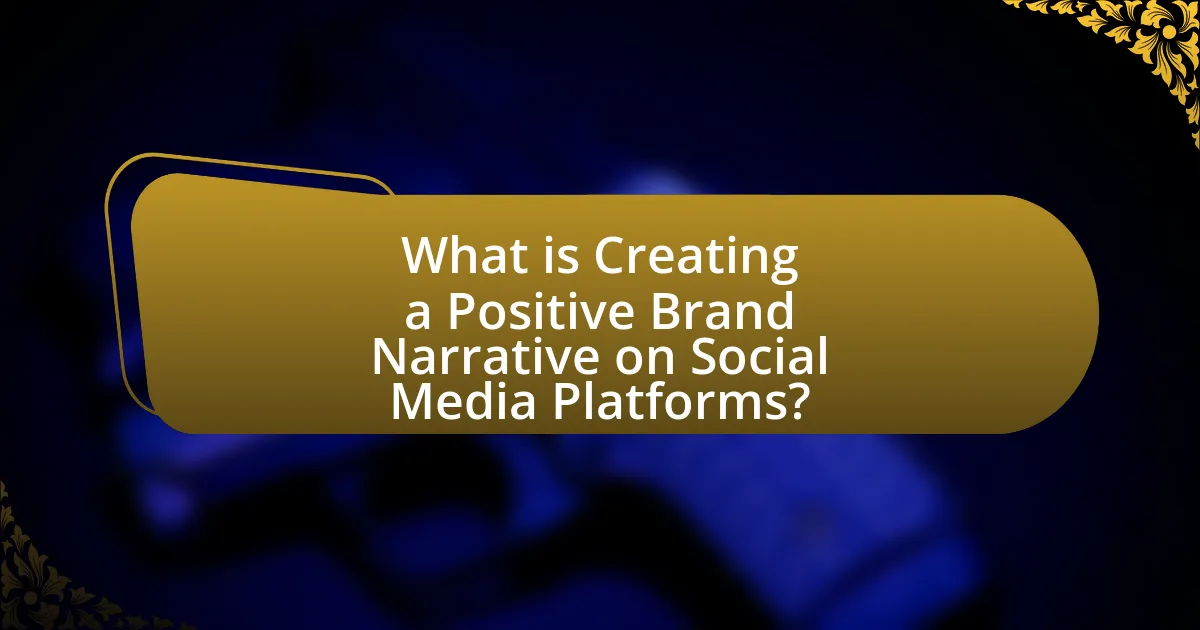Creating a positive brand narrative on social media platforms is essential for fostering customer trust and loyalty. This article explores the significance of a cohesive brand story that reflects a brand’s values and engages audiences emotionally. Key elements contributing to a compelling narrative include authenticity, emotional connection, and consistency across platforms. The article also discusses strategies for effective storytelling, the impact of user-generated content, and the importance of audience engagement in shaping brand perception. Additionally, it addresses challenges brands may face and offers practical tips for maintaining a positive narrative in a competitive market.

What is Creating a Positive Brand Narrative on Social Media Platforms?
Creating a positive brand narrative on social media platforms involves crafting and sharing a cohesive story that reflects the brand’s values, mission, and personality, while engaging the audience emotionally. This narrative is built through consistent messaging, visual content, and interactions that resonate with the target audience, fostering trust and loyalty. Research indicates that brands with a strong narrative can increase customer engagement by up to 30%, as consumers are more likely to connect with relatable stories rather than mere product promotions.
How does a brand narrative influence consumer perception?
A brand narrative significantly influences consumer perception by shaping how consumers relate to and understand the brand’s identity and values. This narrative creates an emotional connection, which can enhance brand loyalty and trust. For instance, research by the Harvard Business Review indicates that brands with a compelling narrative can increase customer engagement by up to 30%, as consumers are more likely to remember and share stories that resonate with them. Additionally, a strong brand narrative can differentiate a brand in a crowded market, leading to a more favorable perception compared to competitors lacking a clear story.
What elements contribute to a compelling brand narrative?
A compelling brand narrative is built on authenticity, emotional connection, and consistency. Authenticity ensures that the brand’s story reflects its true values and mission, which fosters trust among consumers. Emotional connection engages the audience on a personal level, making the narrative relatable and memorable. Consistency across all platforms reinforces the brand’s identity and message, ensuring that consumers receive a unified experience. Research indicates that brands with a strong narrative can increase customer loyalty by up to 30%, demonstrating the effectiveness of these elements in creating a compelling brand narrative.
How does storytelling enhance brand engagement on social media?
Storytelling enhances brand engagement on social media by creating emotional connections with audiences. When brands share compelling narratives, they foster relatability and authenticity, which can lead to increased customer loyalty. According to a study by the Nielsen Company, 92% of consumers prefer ads that feel like a story rather than traditional advertisements. This preference indicates that storytelling not only captures attention but also encourages sharing and interaction, ultimately driving higher engagement rates.
Why is a positive brand narrative essential for businesses?
A positive brand narrative is essential for businesses because it fosters customer trust and loyalty. When a brand communicates a compelling and uplifting story, it resonates with consumers, leading to stronger emotional connections. Research indicates that 64% of consumers make purchases based on shared values, highlighting the importance of aligning brand narratives with customer beliefs. Additionally, a positive narrative can enhance brand reputation, as 86% of consumers are more likely to trust a brand that shares its story authentically. This trust translates into increased customer retention and advocacy, ultimately driving business growth.
What impact does a positive narrative have on brand loyalty?
A positive narrative significantly enhances brand loyalty by fostering emotional connections between consumers and the brand. When brands communicate uplifting stories, they create a sense of trust and relatability, which encourages repeat purchases and long-term commitment. Research indicates that 64% of consumers make a purchase after watching a branded social video, highlighting the effectiveness of positive storytelling in influencing consumer behavior. Furthermore, brands that consistently share positive narratives often see increased customer retention rates, as consumers feel aligned with the brand’s values and mission.
How can a positive narrative differentiate a brand in a crowded market?
A positive narrative can differentiate a brand in a crowded market by fostering emotional connections with consumers. When a brand communicates a compelling and uplifting story, it resonates with customers, making them more likely to choose that brand over competitors. Research indicates that brands with strong narratives can achieve up to 20% higher customer loyalty, as consumers feel aligned with the brand’s values and mission. This emotional engagement not only enhances brand recall but also encourages word-of-mouth promotion, further solidifying the brand’s position in a saturated market.

What strategies can be employed to create a positive brand narrative?
To create a positive brand narrative, companies should focus on authenticity, storytelling, and engagement. Authenticity builds trust; brands that communicate genuine values and practices resonate more with consumers. Storytelling allows brands to connect emotionally, making their messages memorable and relatable. Engagement through interactive content fosters community and loyalty, encouraging customers to share their experiences. Research indicates that 70% of consumers prefer brands that tell stories over those that simply promote products, highlighting the effectiveness of these strategies in shaping a favorable brand narrative.
How can brands effectively utilize social media platforms for storytelling?
Brands can effectively utilize social media platforms for storytelling by creating authentic, engaging content that resonates with their target audience. This involves leveraging visual elements, such as images and videos, to enhance narratives and using platform-specific features like Instagram Stories or Twitter threads to deliver cohesive stories. Research indicates that 79% of consumers prefer brands that tell stories, highlighting the importance of emotional connection in marketing. Additionally, brands should encourage user-generated content, as it fosters community and trust, with 79% of people saying user-generated content highly impacts their purchasing decisions. By consistently sharing relatable and meaningful stories, brands can strengthen their identity and build lasting relationships with consumers.
What types of content resonate most with audiences on social media?
Visual content, particularly images and videos, resonates most with audiences on social media. Studies show that posts with visuals receive 94% more views than those without. Additionally, engaging formats like live videos and stories foster higher interaction rates, with live videos generating six times more interactions than standard videos. This preference for visual storytelling aligns with the human brain’s ability to process images 60,000 times faster than text, making visual content a powerful tool for brands aiming to create a positive narrative.
How can user-generated content enhance a brand’s narrative?
User-generated content enhances a brand’s narrative by providing authentic and relatable stories that resonate with consumers. This type of content allows brands to showcase real experiences and testimonials from their customers, which can foster trust and credibility. According to a study by Nielsen, 92% of consumers trust organic, user-generated content more than traditional advertising, highlighting its effectiveness in shaping perceptions. By integrating user-generated content into their marketing strategies, brands can create a more engaging and dynamic narrative that reflects the voices of their community, ultimately driving brand loyalty and engagement.
What role does audience engagement play in shaping a brand narrative?
Audience engagement is crucial in shaping a brand narrative as it fosters a two-way communication channel between the brand and its audience. This interaction allows brands to gather insights, adapt their messaging, and create content that resonates with their target demographic. For instance, a study by Nielsen found that 92% of consumers trust recommendations from individuals over brands, highlighting the importance of audience involvement in reinforcing brand stories. Engaging with the audience not only enhances brand loyalty but also encourages user-generated content, which can further amplify the brand narrative through authentic testimonials and shared experiences.
How can brands encourage interaction and feedback from their audience?
Brands can encourage interaction and feedback from their audience by actively engaging with them through various social media strategies. Implementing polls, questions, and interactive content such as quizzes can stimulate audience participation. Additionally, responding promptly to comments and messages fosters a sense of community and encourages further dialogue. According to a study by Sprout Social, 70% of consumers feel more connected to brands that respond to their inquiries, highlighting the importance of responsiveness in building engagement.
What are the best practices for responding to audience comments and messages?
The best practices for responding to audience comments and messages include timely responses, personalized engagement, and maintaining a positive tone. Timely responses demonstrate that the brand values its audience, with studies showing that 42% of consumers expect a response within an hour. Personalized engagement, such as addressing users by name and referencing their specific comments, fosters a sense of connection and loyalty. Maintaining a positive tone, even in the face of criticism, helps to uphold the brand’s image and can turn negative interactions into opportunities for improvement. These practices are essential for creating a positive brand narrative on social media platforms.

What challenges might brands face when creating a positive narrative?
Brands face several challenges when creating a positive narrative, including authenticity, audience perception, and consistency. Authenticity is crucial; if a brand’s narrative is perceived as insincere or disconnected from its actual practices, it can lead to backlash. For example, a study by the Harvard Business Review found that 64% of consumers say that shared values are the primary reason they have a relationship with a brand. Audience perception also plays a significant role; brands must navigate diverse opinions and cultural sensitivities, which can complicate messaging. Furthermore, maintaining consistency across various platforms is essential; inconsistency can confuse consumers and dilute the brand’s message. According to a report by Sprout Social, 70% of consumers feel more connected to brands with consistent messaging. These challenges require careful strategy and execution to ensure a positive brand narrative is effectively communicated.
How can brands manage negative feedback on social media?
Brands can manage negative feedback on social media by responding promptly and professionally to the criticism. This approach demonstrates that the brand values customer opinions and is committed to resolving issues. Research indicates that 70% of consumers expect a response to their complaints within 24 hours, highlighting the importance of timely engagement. Additionally, brands should acknowledge the feedback, apologize if necessary, and offer solutions or alternatives to rectify the situation. This strategy not only mitigates the immediate negative impact but also fosters trust and loyalty among customers, as they perceive the brand as responsive and responsible.
What strategies can mitigate the impact of negative comments?
To mitigate the impact of negative comments, brands can implement proactive engagement strategies, such as responding promptly and professionally to criticism. This approach demonstrates that the brand values customer feedback and is committed to resolving issues. Research indicates that timely responses can improve customer satisfaction by up to 70%, as consumers appreciate acknowledgment and resolution efforts. Additionally, brands can focus on building a positive community by encouraging satisfied customers to share their experiences, which can dilute the visibility of negative comments. Engaging in regular monitoring of social media channels allows brands to identify and address potential issues before they escalate, further protecting their reputation.
How can brands turn negative experiences into positive narratives?
Brands can turn negative experiences into positive narratives by actively engaging with customers, acknowledging their concerns, and demonstrating a commitment to improvement. For instance, when a brand faces criticism, responding promptly and transparently can help rebuild trust. A study by the Harvard Business Review found that companies that effectively manage customer complaints can increase customer loyalty by up to 25%. By transforming a negative interaction into a dialogue, brands can showcase their dedication to customer satisfaction and create a narrative that emphasizes growth and responsiveness.
What metrics should brands track to measure the effectiveness of their narrative?
Brands should track engagement metrics, sentiment analysis, reach, and conversion rates to measure the effectiveness of their narrative. Engagement metrics, such as likes, shares, and comments, indicate how well the audience interacts with the narrative. Sentiment analysis helps brands understand the emotional response to their narrative, revealing whether it resonates positively or negatively. Reach measures the number of people exposed to the narrative, providing insight into its visibility. Conversion rates show how effectively the narrative drives desired actions, such as purchases or sign-ups. Collectively, these metrics provide a comprehensive view of narrative effectiveness, enabling brands to refine their storytelling strategies based on audience feedback and behavior.
How can engagement metrics inform narrative adjustments?
Engagement metrics can inform narrative adjustments by providing quantitative data on audience interactions, preferences, and behaviors. For instance, high engagement rates on specific posts indicate that the narrative resonates well with the audience, suggesting that similar themes or tones should be incorporated into future content. Conversely, low engagement metrics may signal a disconnect, prompting a reevaluation of the narrative approach to better align with audience interests. Research shows that brands that adapt their messaging based on engagement data can increase audience retention and brand loyalty, as evidenced by a study from HubSpot, which found that 70% of marketers reported improved engagement after tailoring content based on audience feedback.
What tools can assist in analyzing brand narrative performance on social media?
Tools that can assist in analyzing brand narrative performance on social media include social media analytics platforms, sentiment analysis tools, and engagement tracking software. Social media analytics platforms like Hootsuite and Sprout Social provide insights into audience engagement, reach, and overall performance metrics. Sentiment analysis tools such as Brandwatch and Lexalytics evaluate the emotional tone of social media conversations surrounding a brand, helping to gauge public perception. Engagement tracking software, including BuzzSumo, measures how content resonates with audiences by analyzing shares, likes, and comments. These tools collectively enable brands to assess their narrative effectiveness and make data-driven adjustments.
What are some practical tips for creating a positive brand narrative on social media?
To create a positive brand narrative on social media, brands should focus on authenticity, engagement, and storytelling. Authenticity builds trust; brands that share genuine experiences and values resonate more with audiences. Engagement is crucial; responding to comments and messages fosters a sense of community and loyalty. Storytelling allows brands to connect emotionally with their audience, making their message memorable. According to a study by the Content Marketing Institute, 70% of consumers prefer to learn about a company through articles rather than ads, highlighting the effectiveness of storytelling in brand narratives.
How can brands maintain consistency in their messaging across platforms?
Brands can maintain consistency in their messaging across platforms by developing a comprehensive brand guideline that outlines tone, voice, and key messaging points. This guideline ensures that all content creators and marketers adhere to the same standards, regardless of the platform used. For instance, a study by the Content Marketing Institute found that 70% of successful brands use documented content strategies, which include messaging consistency as a key component. By implementing these guidelines and regularly training teams, brands can effectively present a unified narrative that resonates with their audience across various channels.
What are the key elements to include in a brand narrative strategy?
The key elements to include in a brand narrative strategy are authenticity, emotional connection, consistency, and audience engagement. Authenticity ensures that the brand’s story reflects its true values and mission, which builds trust with consumers. Emotional connection involves crafting narratives that resonate with the audience’s feelings and experiences, making the brand relatable. Consistency across all platforms reinforces the brand’s identity and message, ensuring that consumers receive a unified experience. Audience engagement encourages interaction and feedback, allowing the brand to adapt its narrative based on consumer insights. These elements collectively enhance the effectiveness of a brand narrative strategy, fostering a positive perception on social media platforms.

Leave a Reply